Memrise or Duolingo? Find out which of these leading language learning apps is best for YOU. Plus get top tips on how to get the most out of both of them!
Nowadays, it seems like there is an app for everything: getting in touch with friends, watching movies, checking the weather, planning a trip… and, of course, learning foreign languages.
The number of language learning apps increases daily, but for a while now, there have been two in particular that have continually topped the list for best language learning apps. Memrise and Duolingo. You can’t swing a cat without hearing about either of them.
Memrise and Duolingo are both hugely popular apps, with millions of users all over the world. They both offer some great features and benefits, such as an opportunity to learn a foreign language for free, at any time, anywhere in the world. However, there are significant differences between them, as well.
Let’s explore the differences between Memrise and Duolingo and compare their pros and cons, how to get the most out of each app, if it’s worth upgrading to their premium subscription, and finally, which one you should use – Memrise vs Duolingo?
Let’s dive in to see who will win the battle Memrise vs Duolingo.
Looking for something specific? Use these links to jump around.
Table of Contents
- What languages can you learn?
- What is Duolingo?
- How does Duolingo work?
- Where is Duolingo available?
- What is Memrise?
- How does Memrise Work?
- Where is Memrise available?
- Should you upgrade to Duolingo Plus or Memrise Pro?
- Duolingo’s member content
- Memrise’s member content
- Memrise vs Duolingo: Pros and Cons
- Top 10 Tips: How to get the most out of Memrise and Duolingo
- My top 2 alternative language learning apps
- Memrise vs Duolingo: The winner is…!
Memrise vs Duolingo: What languages can you learn?
One of the advantages of both Memrise and Duolingo is the sheer number of languages they offer. This is great when you are still deciding which language to learn, want to learn multiple languages at a time, or want to join a community of like-minded language learners, no matter what their target language is.
Currently, for English speakers, there are 36 languages available on Duolingo. On Memrise there are 16 languages available in the app that are official Memrise staff-generated courses. Memrise also has countless other languages available on their website too which are user-generated. Since new ones appear regularly, it is hard to pinpoint the exact number.
Note: Languages marked with an (*) are featured in the Memrise app and contain official content created by Memrise staff. The other ones have user-generated courses not offered in the app, although, if you add a course on the website and start learning, you can have access to it in the app as well.
Memrise vs Duolingo: Available languages on both apps
| Arabic* | Japanese* |
| Chinese (Mandarin)* | Klingon |
| Czech | Korean* |
| Danish* | Latin |
| Dutch* | Navajo |
| Esperanto | Polish* |
| Finnish | Portuguese* |
| French* | Norwegian* |
| German* | Romanian |
| Greek | Russian* |
| Hawaiian | Scottish Gaelic |
| Hebrew | Spanish* |
| High Valyrian | Swahili |
| Hindi | Swedish* |
| High Valyrian | Turkish* |
| Hungarian | Ukrainian |
| Indonesian | Vietnamese |
| Irish | Welsh |
| Italian* |
Languages available only on Memrise
Memrise has hundreds (maybe even thousands!) of user-generated courses In various languages (including several sign languages, Morse code, and Braille), that is why this may not be a complete list.
Azerbaijani, Afrikaans, Albanian, Armenian, Ancient Greek, Ancient Egyptian, Aramaic, Akan-Twi, Amharic, Algonquian languages, Anglo-Saxon, ASL, Auslan, Basque, Breton, Bosnian, Bengali, Bulgarian, Belarusian, Burmese, Braille, BSL, Catalan, Croatian, Cornish, Cantonese, Cherokee, Estonian, Faroese, Flemish, Western Frisian, Farsi, Gujarati, Hausa, Hakka, Inuktitut, Icelandic, Khmer, Kyrgyz, Kaonde, Kinyarwanda, Kurdish, Lithuanian, Ladin, Latvian, Lingala, Luganda, Lojban, Lakota, Occitan, Persian, Pashto, Pali, Punjabi, Nepali, Nahuatl languages, New Zealand Sign language, Navi, Malai, Maori, Marshallese, Marathi, Mongolian, Macedonian, Morse code, Serbian, Slovak, Slovenian, Somali, Sami Languages, Scots, Sanskrit, Sicilian, Soninke, Tagalog, Tibetan, Tweants, Tamil, Thai, Telugu, Urdu, Quechua, Wolof, Xhosa, Yiddish, Zulu, and probably a few others!
What is Duolingo?
 Duolingo is an American language-learning tool available as a website and mobile app. The project was started in 2009 and launched to the public eight years ago, on 19 June 2012, and has been growing in popularity ever since. Duolingo’s mascot, the famous green cartoon owl named ‘Duo’, has even become quite a well-known meme. Currently, the app has over 300 million registered users across the world.
Duolingo is an American language-learning tool available as a website and mobile app. The project was started in 2009 and launched to the public eight years ago, on 19 June 2012, and has been growing in popularity ever since. Duolingo’s mascot, the famous green cartoon owl named ‘Duo’, has even become quite a well-known meme. Currently, the app has over 300 million registered users across the world.
In 2013, Apple awarded Duolingo the iPhone App of the Year, making it the first time an educational application received this honor. Duolingo won Best Education Startup at the 2014 Crunchies, a tech award. More recently, in 2019, Duolingo was named one of Forbes’s ‘Next Billion-Dollar Startups 2019’.
How does Duolingo work?
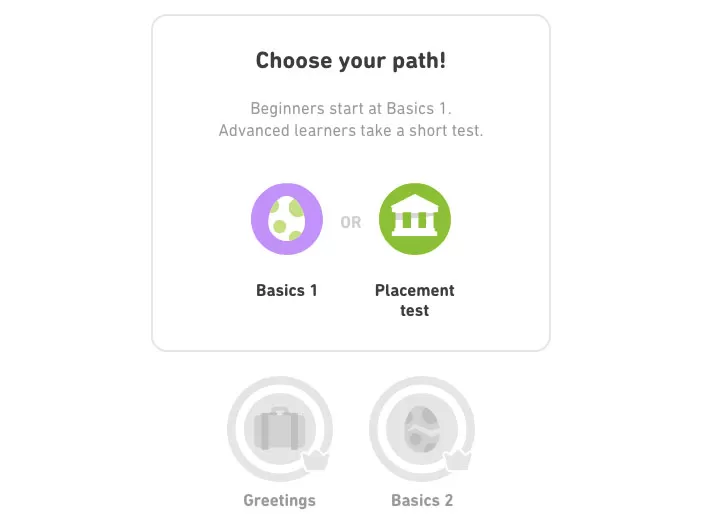 Duolingo essentially offers you a rather comprehensive language course that will take you from a complete beginner to an intermediate level. When you first launch a course, you can either start from the very beginning or, if you have some knowledge of the language, can take a short test that will place you at a more suitable point in the course.
Duolingo essentially offers you a rather comprehensive language course that will take you from a complete beginner to an intermediate level. When you first launch a course, you can either start from the very beginning or, if you have some knowledge of the language, can take a short test that will place you at a more suitable point in the course.
Duolingo lesson structure
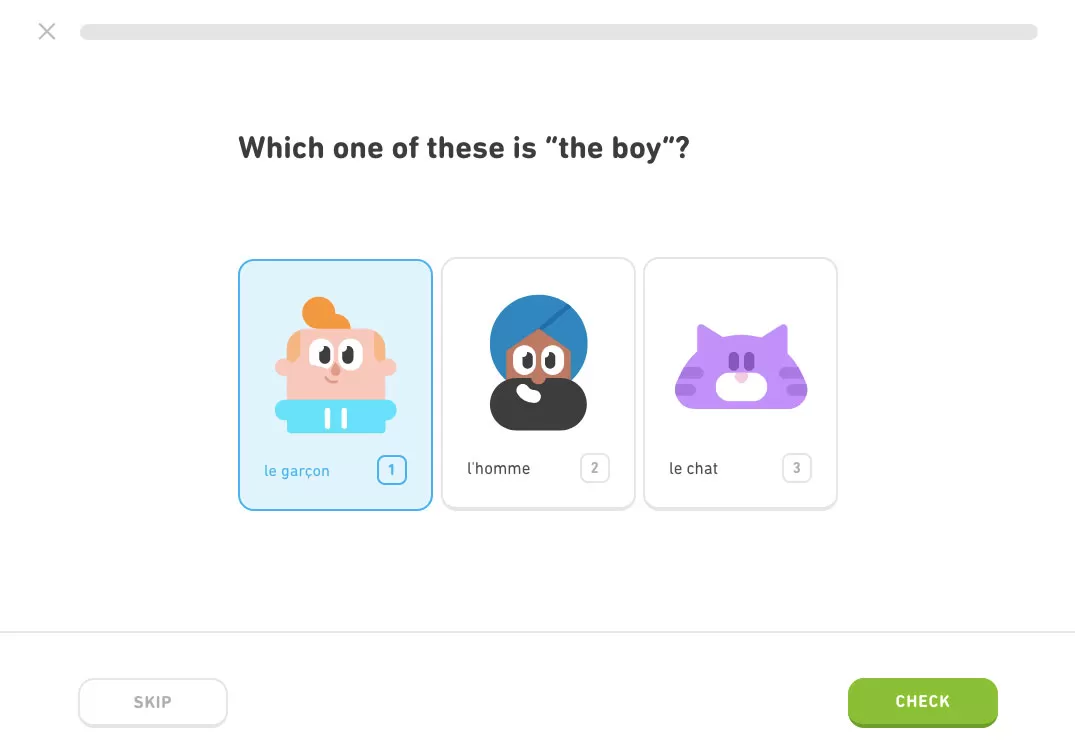 Through language exercises and drills, Duolingo teaches you basic vocabulary and grammar. Some exercises include translating phrases and sentences from English into the target language and vice versa or matching words with their translation. There is also a little bit of listening and pronunciation practice. SH2
Through language exercises and drills, Duolingo teaches you basic vocabulary and grammar. Some exercises include translating phrases and sentences from English into the target language and vice versa or matching words with their translation. There is also a little bit of listening and pronunciation practice. SH2
Gamified Language Learning
To make learning more fun, Duolingo uses elements of gamification. For example, in the iOS version, there are hearts (or ‘health’) that you earn but lose if you make too many mistakes. In all the versions, you get rewarded for successfully performing tasks by the in-app currency called ‘lingots’. You can spend them on features such as character customizations (ie. dress Duo in a track-suit or dress up like a superhero) or bonus levels.
Experience points (XP) and leaderboards
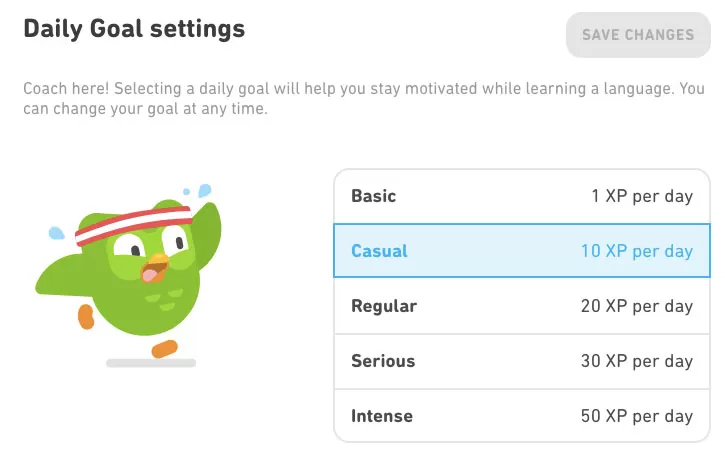 When you complete lessons, you also get XP (experience) points. In the app’s settings, you can set a goal for yourself, how many XP points you want to reach every day. You can also look at XP points to compete with your friends or other Duolingo users. There are weekly leaderboards where you can see your progress compared to other users. If you are motivated by competition, it’s a fun feature to check out.
When you complete lessons, you also get XP (experience) points. In the app’s settings, you can set a goal for yourself, how many XP points you want to reach every day. You can also look at XP points to compete with your friends or other Duolingo users. There are weekly leaderboards where you can see your progress compared to other users. If you are motivated by competition, it’s a fun feature to check out.
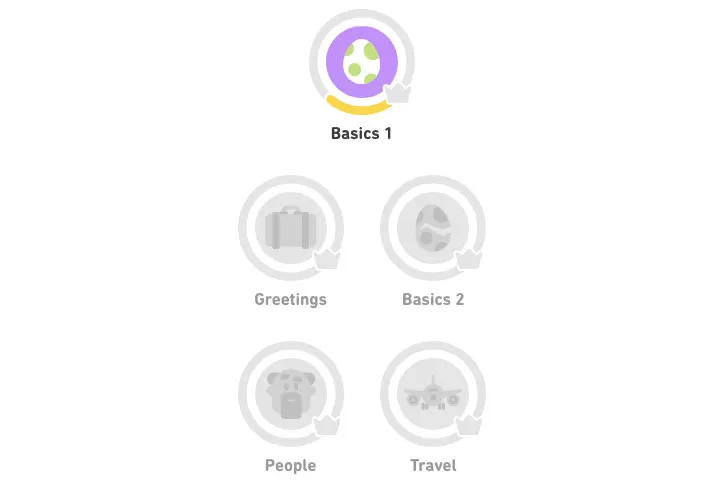 The app’s home screen displays Duolingo’s language-learning tree. Each circle represents a vocabulary or grammar topic, such as ‘Greetings’ or ‘Adjectives’. Each topic has 5 levels, 3-7 lessons each. Each lesson has 10-20 tasks. Depending on your level (and whether you are distracted by social media notifications while practicing), it may take you 5 to 15 minutes to complete one lesson on Duolingo. SH3
The app’s home screen displays Duolingo’s language-learning tree. Each circle represents a vocabulary or grammar topic, such as ‘Greetings’ or ‘Adjectives’. Each topic has 5 levels, 3-7 lessons each. Each lesson has 10-20 tasks. Depending on your level (and whether you are distracted by social media notifications while practicing), it may take you 5 to 15 minutes to complete one lesson on Duolingo. SH3
Tips and discussions
Some Duolingo topics (depending on the language and lesson) have a section called ‘Tips’ where you can read some language rules before starting the exercise, but some lessons are based on intuitive understanding. SH5 After you complete a task, you can sometimes see a ‘Discuss’ option – if you click on it, you will see a discussion of the answer/topic, where other users share their answers, opinions, and comments.
Duolingo Stories and Forums
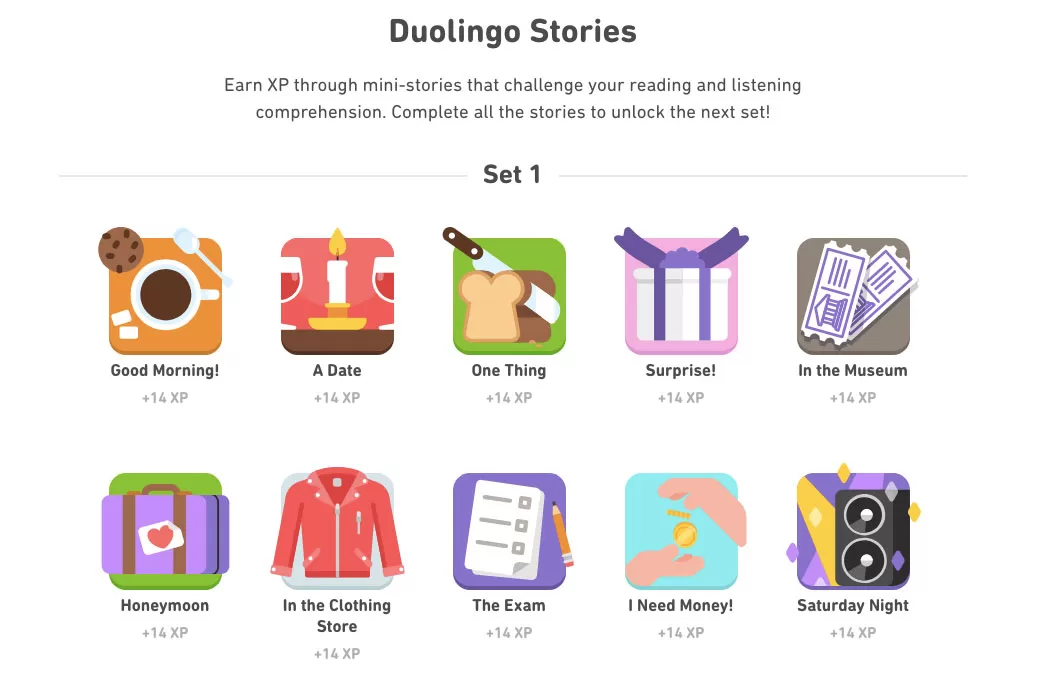 Another great Duolingo feature is the ‘Stories’ section (available for some languages). Here you will find short interactive stories that will challenge your reading and listening comprehension by answering questions about the text. Duolingo Stories are quite fun and a good way to get some extra practice when learning. There are also forums, where you can discuss anything related to Duolingo and foreign language learning with other users.
Another great Duolingo feature is the ‘Stories’ section (available for some languages). Here you will find short interactive stories that will challenge your reading and listening comprehension by answering questions about the text. Duolingo Stories are quite fun and a good way to get some extra practice when learning. There are also forums, where you can discuss anything related to Duolingo and foreign language learning with other users.

Where is Duolingo available?
Duolingo is available as a website, from any browser, and as an app for iOS and Android, although the available features differ slightly. For example, the hearts that you can run out of if you make mistakes are in the iOS version only. In the web version, you have an option of timed practice: you get a few extra seconds every time you answer correctly, but the time will ultimately run out.
Some users in the forums even say that the full number of features you get may depend on the version of iOS or Android or the browser that you use. It’s a bit frustrating if there is a cool feature that you can’t use simply because you have a different phone model. But, fortunately, the main features are available everywhere.
What is Memrise?
 Memrise is a British language learning tool that uses spaced repetition and flashcards to speed up your rate of learning. The app began as a private beta in 2009, and a public version was launched on 1 October 2012. At first, only 100 users were allowed to sign up to test the app. It became fully available in May 2013. As of 2018, Memrise had 35 million registered users.
Memrise is a British language learning tool that uses spaced repetition and flashcards to speed up your rate of learning. The app began as a private beta in 2009, and a public version was launched on 1 October 2012. At first, only 100 users were allowed to sign up to test the app. It became fully available in May 2013. As of 2018, Memrise had 35 million registered users.
Memrise has received several awards including the London Mini-Seedcamp competition in July 2010. Later that year, Memrise was named as one of the finalists for the 2010 TechCrunch Europas Start-up of the Year. It was selected as one of the Techstars Boston startups in March 2011. Then in May 2017, it was named one of Best App winners of the second edition of the Google Play awards.
How does Memrise Work?
Memrise courses
 Unlike Duolingo, Memrise offers multiple courses for each language. For the 16 languages mentioned above, there are official courses created and curated by staff, but there are also hundreds of courses created by the Memrise community.
Unlike Duolingo, Memrise offers multiple courses for each language. For the 16 languages mentioned above, there are official courses created and curated by staff, but there are also hundreds of courses created by the Memrise community.
Staff-created courses are a bit more in-depth and structured, featuring essential vocabulary and grammar. User-generated courses can be devoted to more specific areas, like particular tenses, eg.‘100 most spoken words’, or even vocabulary from a particular textbook.
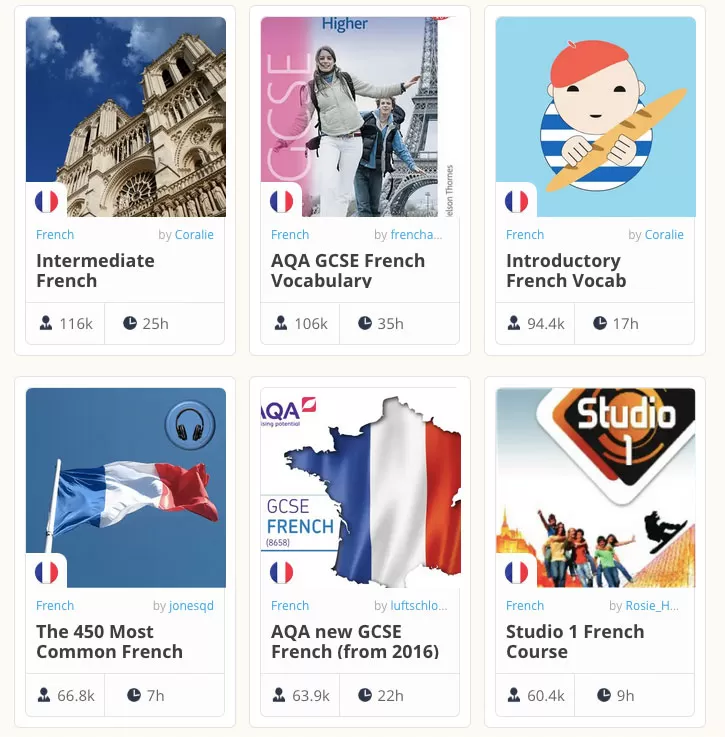
Spaced repetition for optimal learning
The core method applied in Memrise courses is spaced repetition. The spaced repetition method involves presenting you with information before you forget it, ensuring that it stays fresh in your mind.
So, how does spaced repetition work exactly? When you learn new vocabulary, first you review new words a few minutes after seeing it, then again after a day has passed, then a few days, then a few weeks. This way, the vocabulary stays fresh on your mind. At the same time, you’re less frequently exposed to words that you already know well.
This is exactly how Memrise works: you see new words more often, as well as trickier words you may keep making mistakes on; words learned well come up for revision less and less often. You could probably do something similar with physical flashcards, but you would need several boxes to differentiate between words. Seriously, who’s got time for that? Luckily, Memrise can do it all for you.
Customize course duration
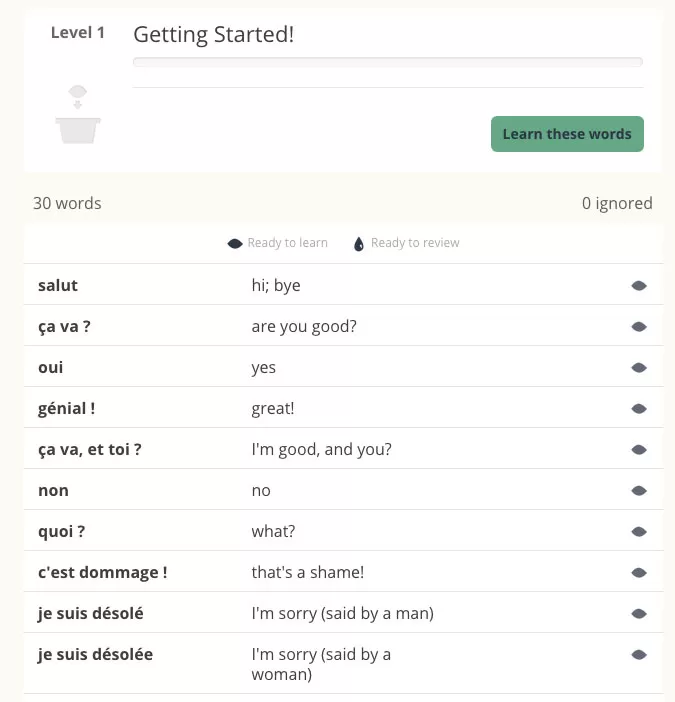 On the Memrise courses page, you can choose which language you speak and which language you want to learn. From here, you will see all the courses available for that combination. Each course consists of several levels; some have 10-20, while others can have up to a hundred.
On the Memrise courses page, you can choose which language you speak and which language you want to learn. From here, you will see all the courses available for that combination. Each course consists of several levels; some have 10-20, while others can have up to a hundred.
For each course, you can see a rough estimate of how much time it takes to complete. Each level represents a selection of useful vocabulary, separate words as well as common phrases and even whole sentences.
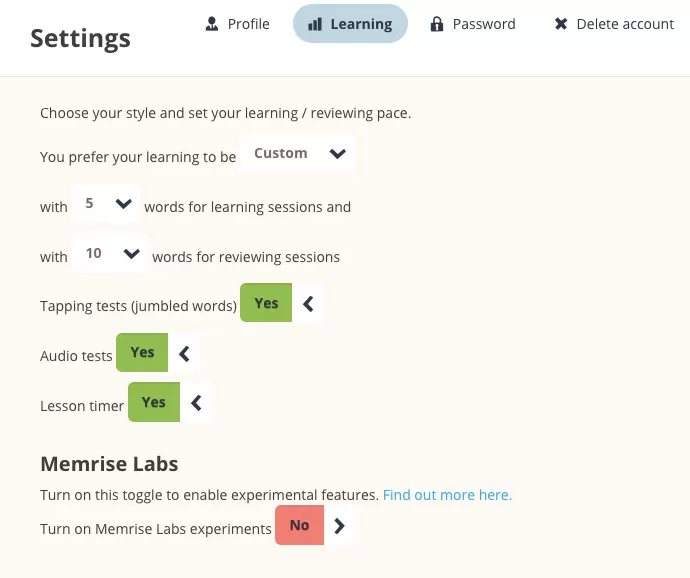 In Memrise, you can select the duration of each individual lesson, for learning new words (5, 10, 15, or 20 words per lesson) and revising the learned vocabulary (5, 10, 25, 50, or 100 words per lesson). This can make a lesson take 5 minutes or up to half an hour if you select 100 words for revision and go relatively slowly about it.
In Memrise, you can select the duration of each individual lesson, for learning new words (5, 10, 15, or 20 words per lesson) and revising the learned vocabulary (5, 10, 25, 50, or 100 words per lesson). This can make a lesson take 5 minutes or up to half an hour if you select 100 words for revision and go relatively slowly about it.
Special features
The main features of the app are learning new words and reviewing what you have already learned. But there are quite a few other features available that can add variety and make learning with flashcards a bit more fun. Unfortunately, not all of these fun features are available in the free version and in all languages.
Learn with Locals
 Some of the extra features include learning grammar, timed speed review, listening practice, pronunciation practice, ‘Learn with Locals’ (short videos recorded by native speakers), reviewing difficult words, chat and grammar bots.
Some of the extra features include learning grammar, timed speed review, listening practice, pronunciation practice, ‘Learn with Locals’ (short videos recorded by native speakers), reviewing difficult words, chat and grammar bots.
Create your own memes
Another fun feature is using Memrise memes to illustrate certain words and phrases: funny pictures that will help you remember vocabulary better (isn’t everything better with memes?). You can also add your own memes and pictures to help you learn the words more effectively – or even create your own course!
Where is Memrise available?
Similarly to Duolingo, Memrise is available as a website, from any browser, and as an app for iOS and Android, with features differing slightly between versions. For instance, in the web version, some of the tasks in the learning sessions are timed. If you don’t reply on time, it counts as a wrong answer and the word will be shown to you again soon (spaced repetition, remember?).
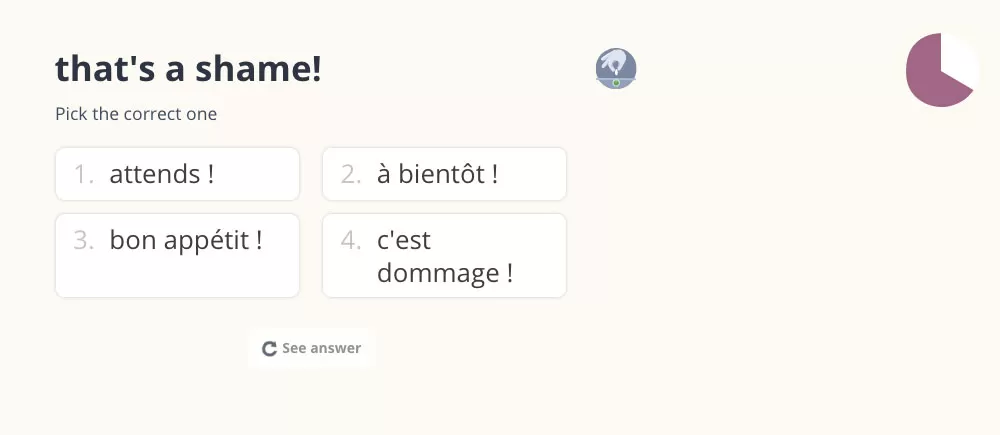
On the iOS version, some additional features are available for some courses, like Immerse (immersive videos) and Explore (using your camera and object recognition to scan the world around you and discover how things are named in your target language).
Memrise vs Duolingo: Should you upgrade to Duolingo Plus or Memrise Pro?
When you are comparing Memrise vs Duolingo, money is not an issue – both apps offer most of their essential features for free. However, both also have a paid subscription option. Let’s find out if it is worth upgrading and paying for Duolingo Plus or Memrise Pro.
Duolingo Plus features
What’s included:
- No ads
- Ability to download lessons in the app for offline use (mobile only)
- Unlimited hearts (iOS only)
- Monthly streak repair
- Progress/mastery quiz (iOS only)
Price: $9.99 per month, $7.99 per month if you pay for 6 months, or $6.99 per month if you pay for a year
Memrise Pro
What’s included:
- Difficult words review
- ‘Learning with Locals’
- Learning statistics
- Chatbots
- Audio review mode
Price: $8.99 per month, $3.75 per month if you pay for a year, or $139.99 for a lifetime subscription. Click here to get started with Memrise
Duolingo’s member content
As I mentioned earlier, Duolingo has a forum section that can be very useful. It is a very friendly and supportive community of language learners from all over the world. You can share your successes, ask questions about the app and your target language, or discuss anything language learning related.
Memrise’s member content
Memrise also has quite an active forum section, but it is essentially a flashcard app. It has one obvious advantage over Duolingo, though: where Duolingo is limited to the lessons they create themselves, Memrise grows whenever members share their own content.
Memrise vs Duolingo: Pros and Cons
Memrise Pros:
- Free!
- User-friendly interface
- Elegant vocabulary-learning tool
- Ability to incorporate user-generated content
- Video clips by native speakers bring the language to life
- Good customization options in the settings
- Strong language-learning content for beginners
- A very wide variety of languages offered
Click here to get started with Memrise
Memrise Cons:
- You are constantly asked if you want to upgrade to the premium version
- The premium features don’t add that much value
- Limited amount of grammar lessons
- Limited amount of content for advanced learners
- Not great for learning sentence structures
- Limited native audio and speaking practice
- The quality of user-generated content can vary greatly
Duolingo Pros:
- Free!
- User-friendly interface.
- Can teach you grammar and sentence structures
- Gamified learning
- Active language forums
- Plenty of native audio and supplementary materials (only for most popular languages)
- Great at getting you to study a little every day
- Clear course structure
Duolingo Cons:
- Needs more relevant sentence examples (some of them are really weird – there is even a Twitter feed dedicated called ShitDuoSays)
- Does not have much content for advanced learners
- Limited (practically non-existent) speaking practice
- Covers a lot of content but isn’t always thorough
- Not great for languages that don’t use the Latin script
Top 10 Tips: How to get the most out of Memrise and Duolingo
As you can see, both language-learning apps have their pros and cons, but here’s how you can make the most out of each app these top language learning hacks and tips.
Top 5 Memrise Hacks and Tips
- Make the most of the memes. The more associations you have with a word or phrase, the better you remember it. Memrise allows you to add images and comments to the words you learn – don’t neglect this feature.
- Customize your learning. With Memrise, you can select how many words you have in each learning/review session. Consider going a bit higher than 5 words – it won’t take too much of your time, but you will learn a little faster.
- Set goals and reminders. You can set a daily goal: how much you want to study, 5, 15, or 45 minutes a day. You can also set the app to remind you to study daily. By doing that, you are more likely to establish a good learning routine and be more disciplined.
- Do not overuse the ‘ignore’ tools. When reviewing words, you have the option to ignore or skip the word completely. And it can be tempting, especially with the longer harder words that have crazy spelling. But don’t immediately give up when you see a word like this and feel like you can’t remember it. Even trying to retrieve such a word from memory is useful – and you may be pleasantly surprised that you remember the spelling after all. You won’t know until you try, so don’t press ‘ignore’ too often.
- Don’t forget to review. It may be tempting to rush forward and learn a lot of new words fast. However, this effort will go completely to waste if you don’t review what you have learned regularly. For spaced repetition to work, you need to… well, to repeat words and phrases.
Top 5 Duolingo hacks and tips
- Combine it with other resources. Duolingo offers a great basic course, but some topics may lack repetition and others – variety. By combining Duolingo with other resources, you will make up for what it is lacking and make your learning much more effective.
- Think of it as a game. Duolingo uses elements of gamification, and you will actually benefit a lot from thinking of it as a game. Don’t treat it as a chore and it will be more fun! Collect XP points and lingots, compete with other users, and simply enjoy yourself.
- Don’t try to be a perfectionist. It’s okay if you make mistakes or don’t get something at the first try. Mistakes are a way of learning, too: just pay attention to the correct variant the app offers, check out comments from other users if needed, and move on.
- Repeat things out loud. When you hear a sentence or a new word, repeat it out loud if you can (or whisper quietly if there are people eavesdropping). This will help you develop muscle memory that will help you be more confident when you speak and remember what you learn even better.
- Be a part of the community. Duolingo has a very active and welcoming community of language learners. If you have questions about the app itself or your target language, or just want some support for extra motivation, visit Duolingo forums – you are most likely to find what you are looking for there.
My top 2 alternative language learning apps
There are a bunch of other language learning resources that I personally love to use. Here are my two favourite app alternatives to Memrise and Duolingo that I recommend you take a look at.
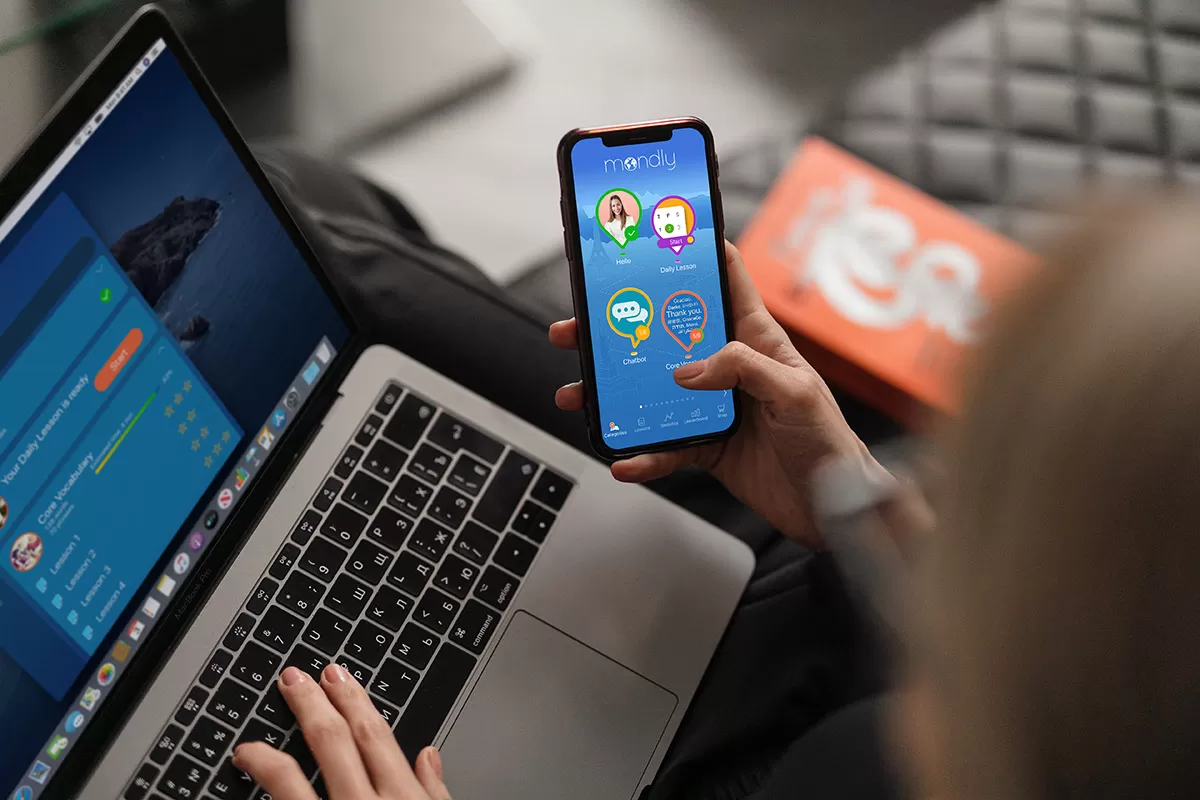
Mondly
It’s no secret that I’ve been a fan of Mondly for years. You can read my full Mondly review here. Its ease of use, friendly interface, and variety of interactive lessons are super important to me. I’m currently using Mondly to learn Norwegian with short bursts of fun and interactive lessons daily. One of the best features of Mondly’s app (which sets it apart from other apps) is that you can learn from your native language. That’s right, you don’t have to be a native English speaker to use the app. This feature is especially useful if you speak other foreign languages and want to keep them fresh while learning another language! They teach numerous languages which aren’t available on many other language learning apps, which is why Mondly is my favourite app of them all. The recently added Bengali, Catalan, Latin, Latvian, Lithuanian, Slovak, Tagalog and Urdu, bringing the total languages available with Mondly to 41! Click here to get 95% OFF Mondly’s Lifetime subscription using my special reader discount.
uTalk
 I also recommend getting uTalk. Available as a desktop site and app, uTalk is awesome for learning key words and phrases in Russian, especially if you want to use it for travel purposes. It’s great for beginners getting started in a language and invaluable for intermediates looking to fill in gaps in their vocabulary and pronunciation.
I also recommend getting uTalk. Available as a desktop site and app, uTalk is awesome for learning key words and phrases in Russian, especially if you want to use it for travel purposes. It’s great for beginners getting started in a language and invaluable for intermediates looking to fill in gaps in their vocabulary and pronunciation.
What I love most about uTalk is that you can jump around their extensive library of topics and choose what you want to learn, when you want, and at your own pace. Because I believe in uTalk so much, I reached out to them and we’ve teamed up to offer you an exclusive 30% OFF reader discount across all of uTalk’s 140 languages! This offer isn’t available anywhere else! Click here to claim your exclusive 30% discount.
Memrise vs Duolingo: The winner is…!
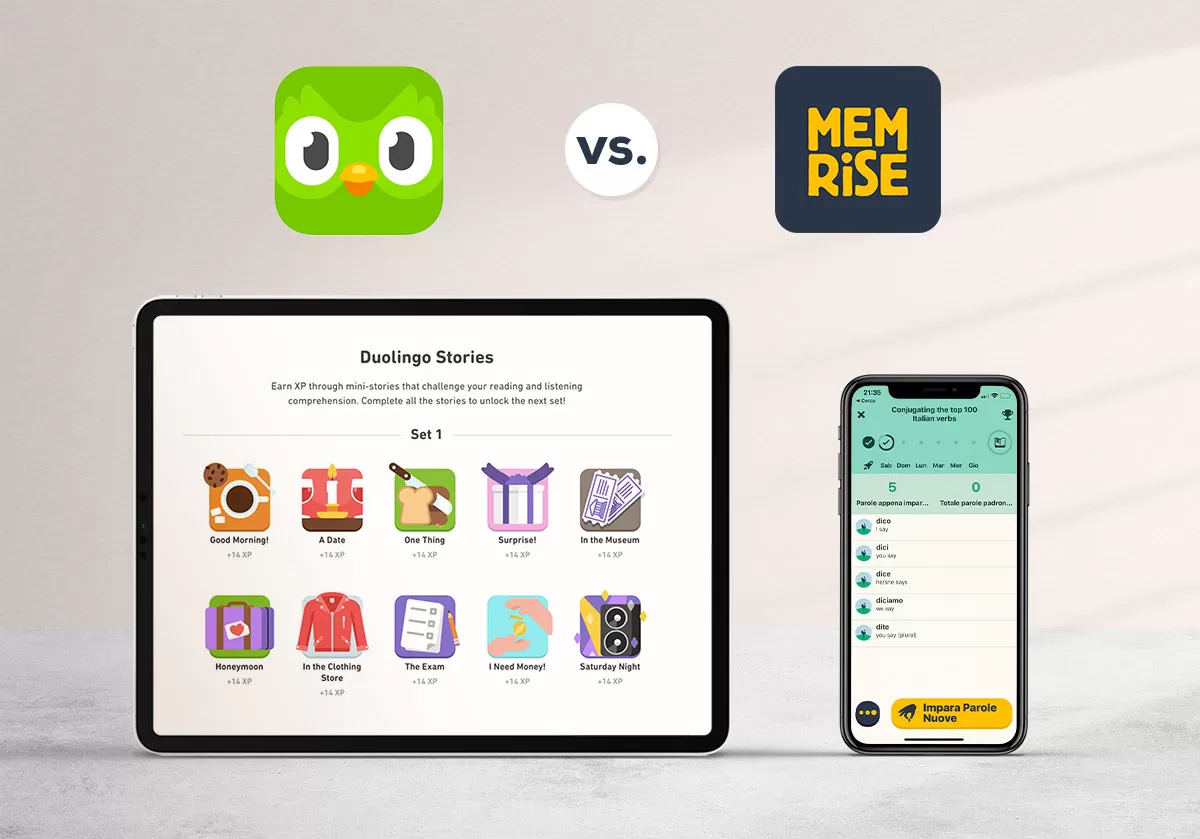 So, who wins in the Memrise vs Duolingo battle? You do, of course! You get access to two amazing FREE language learning tools!
So, who wins in the Memrise vs Duolingo battle? You do, of course! You get access to two amazing FREE language learning tools!
Duolingo has thorough basic courses for many languages, push notifications to keep you on track, and a great community of learners to help you on your language-learning journey.
Memrise offers a great variety of tasks (including videos recorded by native speakers), a wide choice of courses, and a customizable learning experience.
Duolingo is more of a general language learning site with a nice learning curve that everyone can enjoy, whereas Memrise is mostly vocabulary and a flashcard app with a practically endless supply of user-generated content.
Memrise and Duolingo work best together
So, which one is better? Actually, Memrise and Duolingo work best hand-in-hand, they complement each other. Duolingo provides a general outline, a path you can easily follow from start to finish. Memrise offers some extra repetition to help you remember vocabulary better and adds variety to your practice. If you check out some user-created courses, you can even find Memrise courses based on the vocabulary from certain Duolingo courses (such as this German vocabulary course) which makes combining the two even easier.
The two apps use different methods: gradual progression for Duolingo and spaced repetition for Memrise. One is not better than the other, these are just two different approaches, that also work great together.
If they are both great apps, how do I choose? Ask yourself….
What are your goals?
Choosing between the two apps is also a matter of personal preference. You may find Memrise slightly better because Duolingo has a finite number of predetermined courses while Memrise has almost infinite possibilities (in terms of vocabulary) if you’re willing to allocate some time into making your own course.
Memrise is also probably a better choice if you need to focus on revising and expanding your vocabulary. It is also a good choice if you want to create your own flashcards – maybe you’ve read a book and written some vocabulary out that you’d like to commit to your memory.
You may enjoy Duolingo more if you want to avoid the problem of choice. Duolingo is a carefully curated course that takes you from A to B, so you don’t need to worry about which course to choose and whether the quality will be good. It is also a better choice if you want a better balance between vocabulary and grammar, want community support, or enjoy gamification elements – there are simply more of them in Duolingo.
Personal preference
Also, tastes differ, and you may simply like one app more than another. Maybe the colour scheme is more appealing to you, the design more attractive, or you will find one interface easier to use than the other. Fortunately, you can find it out for free without committing to a premium subscription.
Ultimately, there is no right or wrong answer. Both apps are great at fulfilling very specific needs and are the answer to different learners’ questions. Try them both and see which one better suits your needs!
Want to know more about learning languages? Start here!
- How to Learn Languages Like Crazy, Even If You Have a Crazy Life [3-Step Method]
- 22 Top Language Learning Resources You Should Use
- 10 Proven Memory Hacks: How to Remember New Vocabulary Faster
- How to Get Fluent: 9 Reasons You’re Not Fluent…YET! [& What To Do Instead]
- How long does it REALLY take to learn a language? [A Practical Guide]
- 10 Proven Memory Hacks: How to Remember New Vocabulary Faster
- 18 Unexpected Advantages & Health Benefits of Learning A Foreign Language
- 23 Cool Gift for Language Learners They Will Actually Use and Love
- Mondly Review: 10 Ways Mondly Drastically Improved My Language Learning
- 203 Most Beautiful Untranslatable Words [The Ultimate List: A-Z]
- 6 Language Learning Tips: How to Learn a Language from Home
- What Type of Language Learner Are You? Your 4-Step Personalised Learning Plan
- 203 Most Beautiful Untranslatable Words [The Ultimate List: A-Z]
- 44 Best Movies on Disney Plus for Learning Languages
- 13 Ways to Seamlessly Integrate Language Learning into Your Daily Life
- 10 Pro Tips: How to Learn a Language with a Full-Time Job
- 7 Reasons Why You Should Go on a Language Holiday
- Essential Travel Phrases: How to be Travel Fluent in 10 Simple Steps
- How to Learn Your First Foreign Language in 8 Simple Steps: A Beginner’s Guide
- 11 Life-Changing Reasons Why You Should Learn a Language
- 42 beautiful Inspirational Quotes for Language Learners
- Language learning tips: 11 Polyglots Reveal The Secrets of Their Success
- Top 10 Best Ways to Learn a Language Better and Faster
- How Many Languages are there in the World?
- 78 FREE Dictionaries to Learn a Language Fast [Free eBook Download]
- 22 KEY Travel Phrases That Will Transform Your Travels [Free Guide]
Like it? Pin it for later!
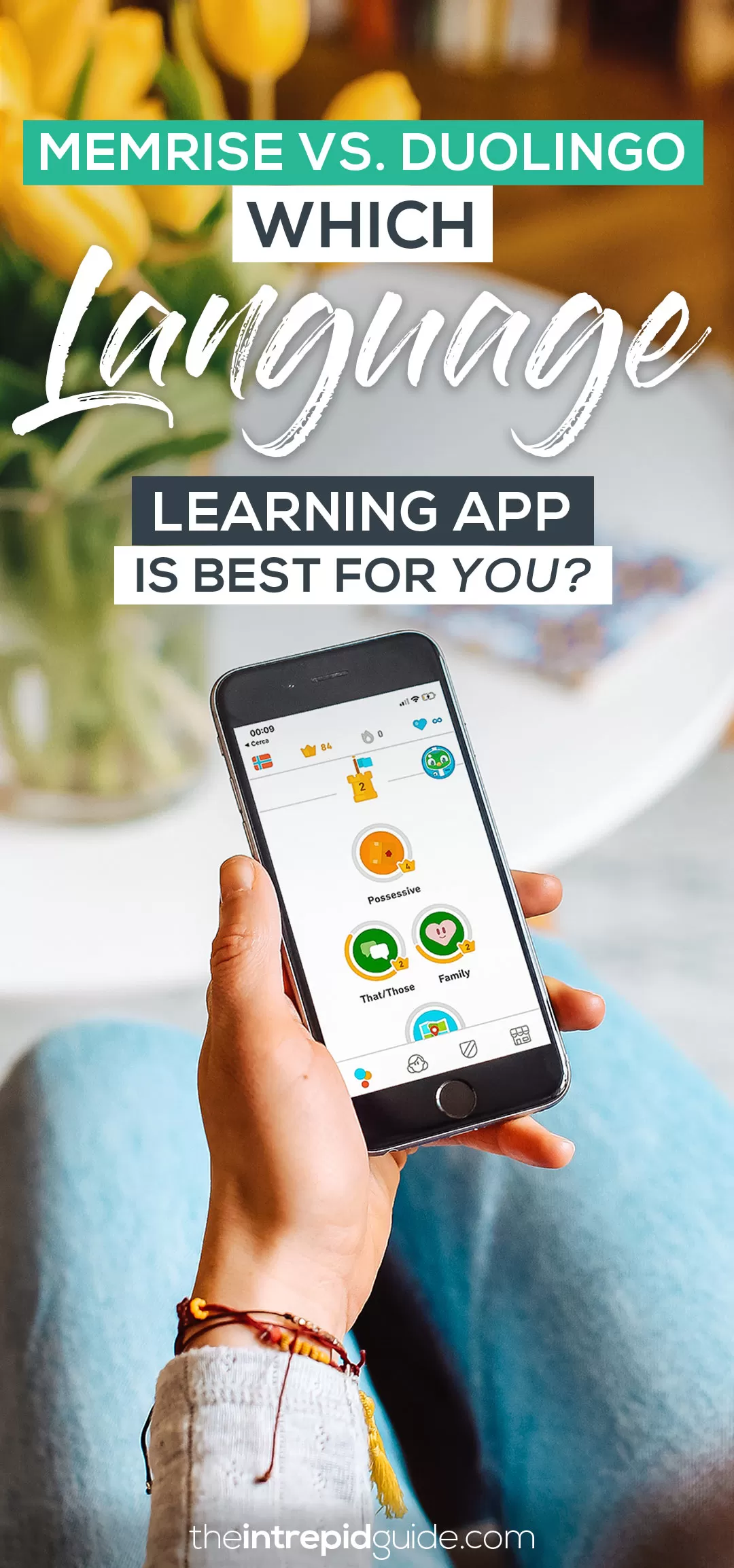
Over to you!
Have you tried Memrise or Duolingo? Do you have a favourite? Do you have a question?
Let me know using the comments section below or join me on social media to start a conversation.
Thanks for reading and I hope you enjoyed this post.
Like what you see? Subscribe using the form below to have all of my posts delivered directly to your email.


2 comments
Thanks for the informative article. Although I didn’t read the entire thing I scanned through it and learned what I wanted to know. I’ve been a Duolingo user for about two years and have enjoyed it. I’ve been slowly working on the German course. You mentioned the stupid phrases they use in their lessons, and I agree that some of them were very dumb. But within the past few months, the German course has been largely revamped. The lessons use phrases that seem more relevant to conversations people would actually have. I restarted the course at lesson one to get the full benefit of the fix.
Thanks for sharingm, Hiland. It’s great to hear they have revamped the content to include more usable phrases :) Best of luck with it. If you want to reach B1 level, I highly recommend this German Uncovered course.